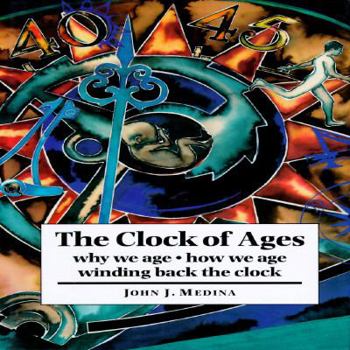The Clock of Ages: Why We Age-- How We Age-- Winding Back the Clock
Select Format
Select Condition 
Book Overview
A few gray hairs and a couple of wrinkles are often the first visible signs of aging on our bodies. For most of us, however, aging remains largely a mystery. We can only wonder why we have to age and... This description may be from another edition of this product.
Format:Hardcover
Language:English
ISBN:0521462444
ISBN13:9780521462440
Release Date:March 1996
Publisher:Cambridge University Press
Length:352 Pages
Weight:1.65 lbs.
Dimensions:1.1" x 6.3" x 9.3"
Related Subjects
Aging Basic Sciences Biological Sciences Biology Biology & Life Sciences Evolution Genetics Health, Fitness & Dieting Health, Fitness & Dieting Medical Medical Books Medicine Parenting & Relationships Personality Physiology Psychology Psychology & Counseling Science Science & Math Science & Scientists Science & Technology Social SciencesCustomer Reviews
4 ratings
A very interesting book
Published by Thriftbooks.com User , 18 years ago
I really enjoyed reading this didactic book, but I was a little dissapointed at the end.... I thought he was going to talk more about diet and life style, but he didn't. Maybe in a future edition, who knows. Anyway, it's a very good book, you should read it.
A journey into the mechanics of aging
Published by Thriftbooks.com User , 24 years ago
Reading this book reminded me of a ride I once took at Disneyland where everything gets bigger and bigger so that you feel as if you are being reduced to microscopic size. You then travel into the human body, then a cell and then see the molecules that make them up. Medina starts with the human face of ageing - the final moments in the life of his aged mother - and then takes us on a journey from the outward signs of ageing to the molecular machinery which makes what he calls the "clock of ages" tick.Despite our anxieties of "getting old" ageing starts long before we see wrinkles or grey hair. In fact, ageing is a complex developmental process which starts at conception. Despite taking such a biological view Medina never loses sight of the individual. The effects of ageing on the lives of many famous people are interspersed through the book with amazing facts about the body: Florence Nightingale was a hypochondriac who spent most of her adult life in bed and each of us contains about 60,000 miles of blood vessels!Some in the field claim that our exploding knowledge of the mechanics of cellular renewal and DNA will see us living twice or three times our current life spans in approximately 30 years.
Good Summary But Missing One Discussion
Published by Thriftbooks.com User , 25 years ago
Medina's work is an excellent, readable summary of what's currently known about aging. As it turns out, there are more questions than answers.However, in amongst all the discussion of immortality I wish he had devoted a chapter to the wisdom of such a quest. He mentions in passing the ants and bees who each perform a distinct function and, separated from their hive or nest, expire rather quickly. Medina repeats the oft-quoted maxim that they are more like a single organism with independently-functioning cells than like distinct individuals.I wish he had extended this analogy to mankind, and showed how immortality would be to the detriment of long-term species survival in a changing environment. "Descent with modifications" relies on continual refreshing of the genetic material. Lewis Thomas and Stephen Jay Gould (and even Richard Dawkins) have put forward the idea that the individual is not the prime target of evolution, and I think this paradigm shift helps explain the causes of, and need for, aging.
"The Clock of Ages" Makes for Good Time
Published by Thriftbooks.com User , 27 years ago
"The Clock of Ages" by John J. Medina is subtitled 'Why We Age, How We Age, Winding Back the Clock.' Dr. Medina more adequately addressed the 'Why' and the 'How' of aging than the 'Winding Back the Clock.' As might be expected from a molecular biologist, Medina is at his most technical and most detailed when he is describing the major theories of aging--error accumulation and programmed death. Generally, he succeeds in clarifying technical concepts for the non-technical reader. The book is liberally seasoned with historical vignettes, analogies and diagrams. "Clock" clarifies various definitions of aging, different philosophies of aging and various theories of the biochemistry of aging. At the same time we are introduced to such diverse people as Casanova, Billy the Kid, Isadora Duncan, Alfred Nobel and Florence Nightingale. The vignettes of these people often liven up the book, but at times the analogies made from person to concept are a bit of a stretch. Medina serves as a tour guide of the aging body with stops at the skin and hair; the bones, the muscles and joints; the brain; the heart; the lungs; the digestive system; the senses; and the sexual anatomy and physiology. "Clock" is mostly a story of decline and fall of the human body with predictions about future high-tech genetic and hormonal antidotes. The third part of the sub-title 'Winding Back the Clock' only consumes 17 of 316 pages which is not in balance with the other two parts. Medina acknowledges but underplays the role of diet and exercise in winding back the clock. And although Dr. Medina recognizes the wide variability in the way people age as well as the variability of aging within individual body systems, he does not fully recognize the affects of culture and attitude on the aging process, but coming from a biologist this is to be expected. Overall, "Clock" is engaging and thought-provoking. I would, however, recommend several other books to give other views on aging other than the biological--try Betty Friedan's "Fountain of Age," Deepak Chopra's "Ageless Body, Timeless Mind" or Delany, Delany & Hearth's "Having Our Say: The Delany Sisters' First 100 Years."





